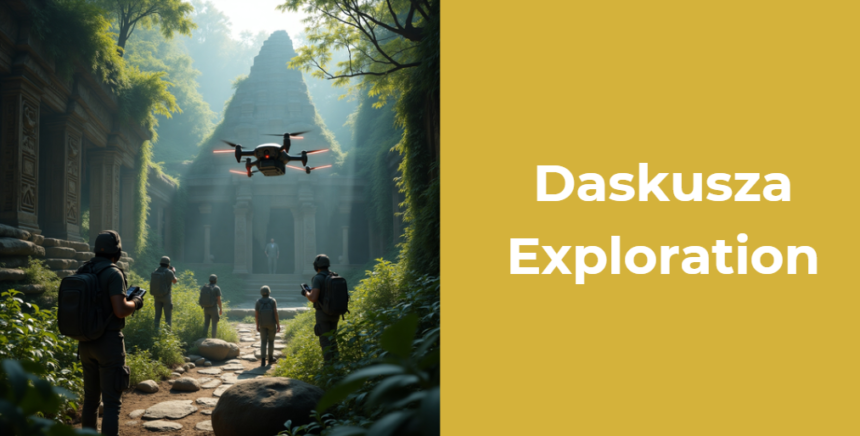Daskusza exploration is a captivating field that bridges ancient lore with modern scientific inquiry. It invites researchers, enthusiasts, and curious minds alike to delve into a realm where history and myth converge.
In this guide, we explore the origins, evolution, and contemporary advancements of daskusza exploration while examining its cultural impact and future potential. Our aim is to provide an in-depth, easy-to-understand resource that not only informs but also inspires further research and adventure in this mysterious domain.
This comprehensive article covers a wide array of topics—from the historical narratives and indigenous legends that first hinted at hidden wonders, to the latest technological tools propelling modern expeditions. By examining diverse perspectives and methodologies, we hope to offer a balanced and enriching overview of daskusza exploration.
Historical Background and Origins
The journey into daskusza exploration begins with the rich tapestry of ancient history and indigenous narratives. Early mentions of lost frontiers and forgotten cities have been passed down through oral traditions and written records, serving as a source of intrigue for generations.
In the early eras, explorers and scholars attempted to decipher cryptic clues left in ancient manuscripts and local folklore. This phase of exploration was marked by a blend of myth and method, where imaginative storytelling met the rigors of early archaeological practice. For instance, some cultures detailed mysterious “steps” or milestones that, according to legend, signified points of transition in human history.
To illustrate the progression of historical milestones in daskusza exploration, consider the table below:
| Historical Milestone | Approximate Era | Key Event | Significance |
|---|---|---|---|
| Ancient Oral Traditions | Prehistoric | Early myths of hidden cities and lost wisdom | Foundation of exploratory legends |
| Medieval Manuscript Discoveries | 12th – 15th century | Codices and maps hinting at lost frontiers | Sparked interest among early scholars |
| Early Modern Expeditions | 17th – 19th century | Documented travels and first recorded encounters | Laid groundwork for scientific inquiry |
| 20th Century Technological Advances | 1900s | Integration of archaeological techniques | Transition to modern research methods |
This timeline not only provides context but also highlights the layered evolution of daskusza exploration from myth to measurable inquiry.
Theories and Interpretations
Throughout its history, daskusza exploration has been the subject of various theories that blend science and mythology. Early interpretations were often colored by the cultural and religious contexts of their times, while modern perspectives incorporate advanced analytical methods.
Researchers now compare traditional narratives with empirical evidence, creating a dialogue between the mystical and the measurable. The following aspects are typically considered:
- Scientific Perspectives:
Modern researchers employ techniques such as carbon dating, geospatial analysis, and remote sensing to validate historical accounts. These methods have helped transform vague legends into testable hypotheses. - Mythical Interpretations:
Many ancient stories carry symbolic meanings. Scholars often debate whether these narratives should be taken literally or seen as allegorical guides to nature’s cycles and human existence. - Comparative Analysis:
By comparing daskusza exploration with other lost cities and ancient phenomena, researchers can identify common themes and discrepancies that enrich our understanding of human history. - Expert Opinions:
Academic debates continue as experts from various disciplines—history, archaeology, and anthropology—share insights that sometimes challenge the mainstream narrative of daskusza exploration.
Modern Discoveries and Technological Advances
In recent decades, technological breakthroughs have revolutionized the way we approach daskusza exploration. Researchers now have access to high-tech tools that were unimaginable just a few generations ago. The integration of drones, LIDAR, and advanced GIS mapping has dramatically improved the accuracy of locating and analyzing hidden sites.
For instance, aerial drone surveys allow explorers to capture high-resolution images of vast terrains, while LIDAR technology penetrates dense vegetation to reveal underlying structures. Digital mapping techniques then compile these images into comprehensive, interactive maps that guide further fieldwork.
A brief list of modern tools includes:
- Drones: For aerial surveys and real-time mapping.
- LIDAR: To detect subtle features obscured by natural cover.
- GIS Software: For compiling and analyzing spatial data.
- Remote Sensing: To monitor changes in landscapes over time.
These innovations have not only validated many historical claims but also uncovered entirely new aspects of daskusza exploration that were previously hidden from view.
Daskusza Exploration in Popular Culture
The allure of daskusza exploration extends beyond academic circles and has captured the imagination of the public. Movies, documentaries, and books have portrayed the excitement of uncovering lost secrets, blending real discoveries with fictional dramatizations.
Popular media often highlights the romance of exploration, portraying brave adventurers who venture into uncharted territories. Social media platforms and online communities have further amplified this interest, with enthusiasts sharing their own interpretations and field experiences. This cultural phenomenon has had a significant impact on tourism in regions linked to daskusza exploration, drawing visitors eager to connect with history and mystery.
Methodologies and Best Practices
A robust understanding of daskusza exploration requires adherence to proven research methodologies and ethical practices. Researchers balance traditional fieldwork with modern scientific methods to ensure that every expedition is both respectful of local heritage and methodologically sound.
The process typically involves the following steps:
- Preliminary Research: Reviewing ancient texts, historical maps, and local oral traditions to form initial hypotheses.
- Fieldwork Preparation: Equipping teams with the latest technological tools and ensuring adherence to safety and ethical guidelines.
- Data Collection: Employing systematic methods such as grid mapping and sample excavation to gather reliable data.
- Analysis and Documentation: Using both qualitative and quantitative methods to analyze findings, which are then published in peer-reviewed journals.
Integrating traditional knowledge with modern science ensures that daskusza exploration remains both rigorous and culturally sensitive.
Case Studies and Notable Expeditions
Over the years, several expeditions have provided groundbreaking insights into daskusza exploration. These case studies highlight the diversity of approaches and outcomes in the field. Below is a table summarizing a few landmark expeditions:
| Expedition Name | Year | Key Findings | Remarks |
|---|---|---|---|
| The Pioneer Survey | 1998 | Uncovered previously unknown ruins and artifacts | Marked the transition to technology-driven research |
| The Horizon Project | 2005 | Utilized LIDAR to reveal hidden structures in dense forests | Set new standards in remote sensing techniques |
| The Revival Expedition | 2012 | Combined local oral histories with archaeological data | Enhanced collaboration between scientists and indigenous communities |
| The Future Frontier Initiative | 2020 | Integrated AI-driven analysis to predict excavation sites | Represents the cutting edge of predictive modeling |
These expeditions illustrate how diverse approaches converge to expand our understanding of daskusza exploration and its impact on our comprehension of the past.
Challenges, Controversies, and Criticisms
No field of study is without its controversies, and daskusza exploration is no exception. One of the primary challenges is the delicate balance between myth and science. Skeptics often question the validity of interpretations derived from ancient legends, while proponents argue that these narratives offer valuable insights when combined with empirical data.
There are also practical challenges such as funding limitations, environmental concerns, and the potential for cultural insensitivity. Ethical debates continue over the methods of excavation and the treatment of indigenous knowledge, prompting ongoing discussions within the research community.
Addressing these challenges requires transparency, rigorous peer review, and a willingness to question established narratives, ensuring that daskusza exploration remains a dynamic and evolving field.
Future Prospects and Emerging Research
The future of daskusza exploration looks promising, with emerging technologies and methodologies opening new avenues for research. Upcoming expeditions are increasingly collaborative, involving interdisciplinary teams that combine the expertise of historians, archaeologists, technologists, and local community leaders.
Innovative approaches such as AI-powered data analysis, enhanced remote sensing capabilities, and immersive virtual reality experiences are beginning to transform how discoveries are made and shared. Additionally, the growing trend of citizen science is encouraging amateur explorers to contribute data and insights, democratizing the field and expanding its scope.
The following list encapsulates some of the most exciting prospects:
- Advanced AI Integration: Enhancing predictive models for identifying potential sites.
- Virtual Reality Tours: Allowing the public to experience explorations in immersive formats.
- Interdisciplinary Collaborations: Combining diverse expertise to enrich research outcomes.
- Sustainable Fieldwork Practices: Ensuring that future explorations are environmentally and culturally responsible.
Conclusion and Final Thoughts
In summary, daskusza exploration is a multifaceted field that bridges ancient legends with modern technology. This guide has taken you on a journey from the historical origins and early myths to contemporary advancements and future innovations. By embracing both traditional knowledge and modern scientific techniques, researchers are not only unveiling the secrets of lost frontiers but also inspiring a new generation of explorers.
The dynamic interplay between myth and method in daskusza exploration offers a profound reminder that our past continues to shape our present—and, indeed, our future. We encourage readers, researchers, and enthusiasts to delve deeper into this field, contribute their own findings, and join the ongoing quest to uncover the mysteries that lie hidden beneath the sands of time.
FAQs
1: What are the potential career paths for someone interested in exploring the realm of daskusza exploration?
Individuals drawn to this fascinating field can pursue a variety of career options that bridge technology, history, and cultural studies. While many may find opportunities in traditional archaeology or historical research, the unique nature of daskusza exploration also opens doors in emerging areas.
For instance, professionals with skills in remote sensing, GIS mapping, or digital data analysis can contribute significantly to non-invasive exploration methods. Additionally, roles in cultural heritage management, sustainable tourism, and even technology development focused on exploration tools are expanding.
Many organizations and research institutions encourage cross-disciplinary expertise, meaning that internships, volunteer programs, and specialized academic courses can serve as valuable stepping stones into a rewarding career in this innovative field.
2: How might future technological innovations enhance the practice of daskusza exploration?
While current advancements such as drones, LIDAR, and AI-driven data analysis are already revolutionizing exploration, the future holds even greater potential. Researchers are looking at quantum computing to process large datasets more efficiently, which could further refine predictive models for site detection.
Innovations in sensor technology and augmented reality could allow explorers to virtually reconstruct historical sites in real time, offering immersive experiences both for academic research and public engagement.
Furthermore, blockchain technology is being considered for secure and transparent documentation of discoveries, ensuring that data integrity is maintained as exploration projects expand globally.
3: What are some common misconceptions about daskusza exploration that newcomers should be aware of?
There are several myths that can mislead those new to this field. One misconception is that every ancient legend directly translates to a verifiable historical site. In reality, many stories are symbolic and require careful interpretation alongside scientific data.
Another frequent misunderstanding is the expectation that technology alone will instantly reveal all hidden secrets; the process is iterative and relies heavily on both meticulous fieldwork and contextual analysis.
Finally, some believe that exploration activities have no significant risks or challenges, whereas ethical concerns, legal constraints, and the preservation of cultural integrity remain central issues that must be managed with great care.
4: In what ways does daskusza exploration contribute to the conservation of cultural heritage?
The methods and discoveries in daskusza exploration have a profound impact on preserving cultural heritage. By employing non-invasive technologies, researchers can document and analyze historical sites without causing damage, which is crucial for protecting vulnerable artifacts and structures.
Collaborations with local communities and cultural experts further ensure that explorations are conducted with sensitivity toward indigenous traditions and historical narratives.
These efforts not only enrich our understanding of the past but also provide tangible evidence that can support the creation of conservation policies and heritage management programs, benefiting both academic research and the local populace.
5: What future research initiatives or collaborations are on the horizon for advancing daskusza exploration?
The landscape of daskusza exploration is set to become even more dynamic through upcoming research initiatives and international collaborations. Several interdisciplinary projects are in development, aiming to integrate expertise from historians, technologists, and cultural conservationists.
For example, new funding initiatives are encouraging partnerships between academic institutions and private tech companies to develop specialized exploration tools.
In addition, collaborative projects are being designed to share data and resources across borders, thereby fostering a more unified global approach to uncovering and preserving lost historical treasures. These initiatives promise to enhance both the scope and precision of future discoveries in this captivating field.
Other Posts Like Daskusza Exploration
The Ultimate Guide to le creuset 11-19 blau schale
The Ultimate Guide to 461_mortal_k_4_25_u76.u76











